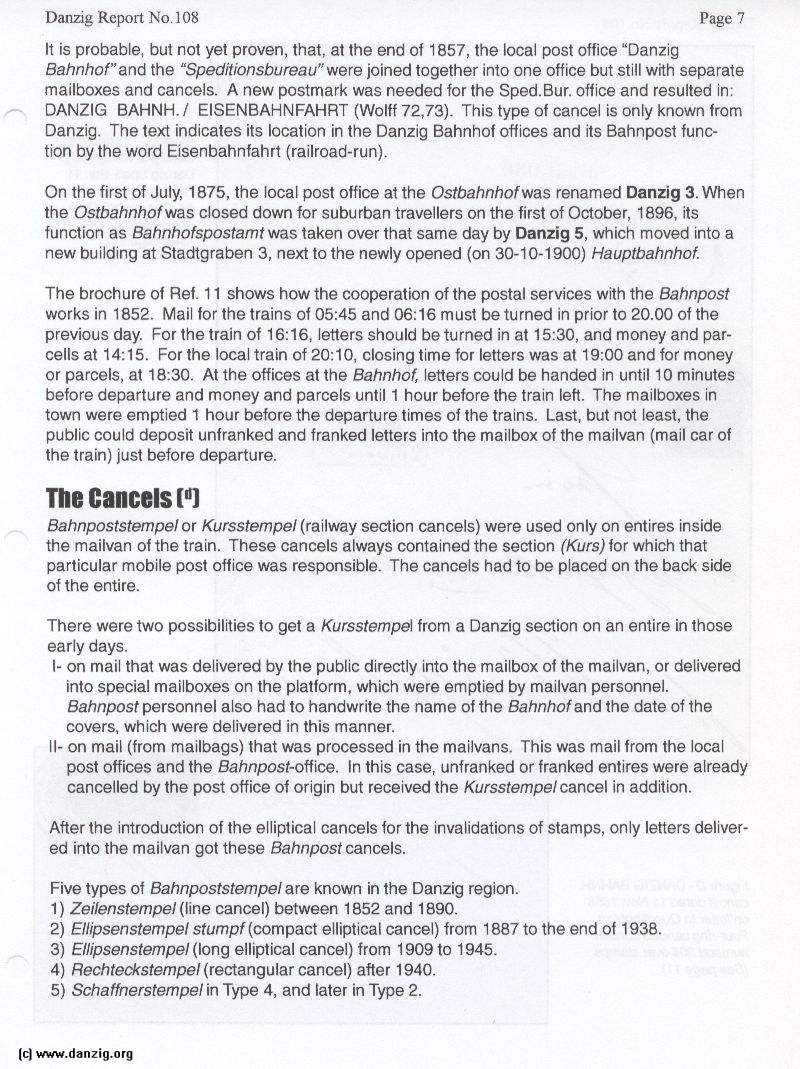
It is probable, but not yet proven, that, at the end of 1857, the local post office NDanzig Bahnhof”and the “Spediticxisbu reau” were joined together into one office but still with separate mailboxes and cancels. A new postmark was needed for the Sped.Bur. office and resulted in: DANZIG BAHNH. I EISENBAHNFAHRT (Wolff 72,73). This type of cancel is only known from Danzig. The text indicates its location in the Danzig Bahrihof offices and its Bahnpost furict ion by the word Eisenbahnfahrt (railroad-run).
On the first of July, 1875, the local post office at the Ostbahnhof was renamed Danzig 3. When the Ostbahnhof was closed down for suburban travellers on the first of October, 1896, its function as Bahnhofspostamt was taken over that same day by Danzig 5, which moved into a new building at Stadtgraben 3, next to the newly opened (on 30-10-1900) Hauptbahnhof.
The brochure of Ref. 11 shows how the cooperation of the postal services with the 8ahnpost works in 1852, Mail for the trains of 05:45 and 06:16 must be turned in prior to 20.00 of the previous day. For the train of 16:16, letters should be turned in at 15:30, and money and par- cells at 14:15. For the local train of 20:10, closing time for letters was at 19:00 and for money or parcels, at 18:30. At the offices at the Bahnhof, letters could be handed in until 10 minutes before departure and money and parcels until 1 hour before the train left. The mailboxes in town were emptied 1 hour before the departure times of the trains. Last, but not least, the public could deposit unf ranked and franked letters into the mailbox of the mailvan (mail car of the train) just before departure.
The Cancels
Bahnpoststempel or Kursstempe! (railway section cancels) were used only on entires inside the mailvan of the train. These cancels always contained the section (Kurs) for which that particular mobile post office was responsible. The cancels had to be placed on the back side of the entire.
There were two possibilities to get a Kursstempel from a Danzig section on an entire in those early days.
I- on mail that was delivered by the public directly into the mailbox of the mailvan, or delivered into special mailboxes on the platform, which were emptied by mailvan personnel. Bahnpost personnel also had to handwrite the name of the Bahnhof and the date of the covers, which were delivered In this manner.
II- on mail (from mailbags) that was processed in the mailvans. This was mail from the local post offices and the Bahnpost-off ice. In this case, unf ranked or franked entires were already cancelled by the post office of origin but received the Kursstempel cancel in addition.
Alter the introduction of the elliptical cancels for the invalidations of stamps, only letters delivere d into the mailvan got these Bahnpost cancels.
Five types of Bahnpoststempel are known in the Danzig region.
1) Zeilenstempel(Iine cancel) between 1852 and 1890.
2) Ellipsenstempel stumpf (compact elliptical cancel) from 1887 to the end of 1938.
3) Ellipsenstempel (long elliptical cancel) from 1909 to 1945.
4) Rechtec*stempel (rectangular cancel) after 1940.
5) Schaffnerstempel in Type 4, and later in Type 2.
Danzig Report Vol. 1 - Nr. 108 - July - August - September - 2000, Page 7.
Hits: 3758
Added: 28/07/2015
Copyright: 2025 Danzig.org

